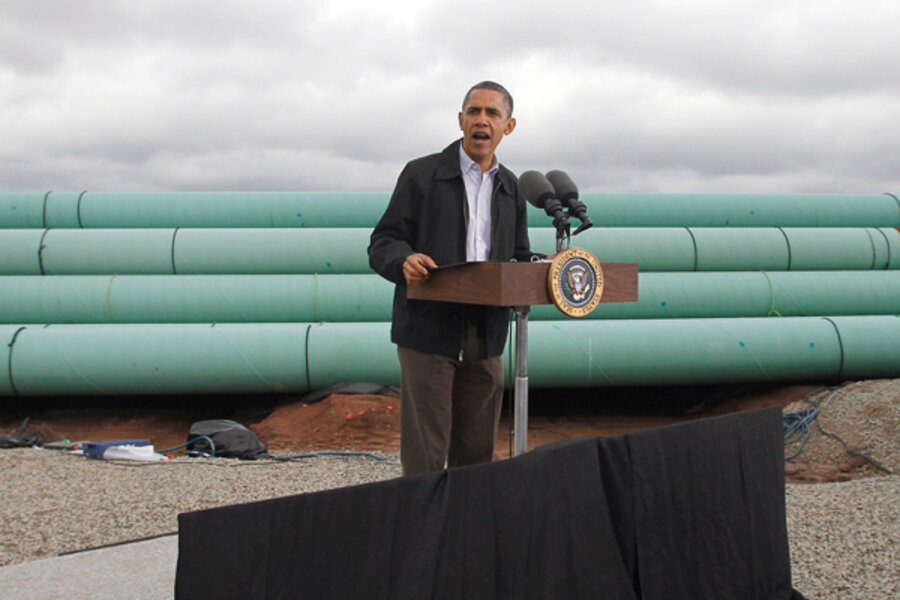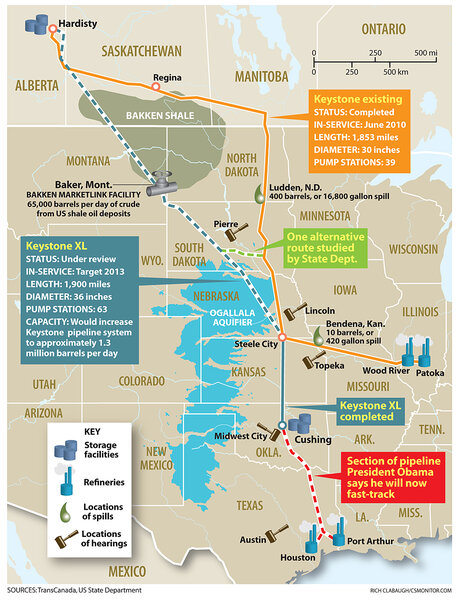Obama fast-tracks part of Keystone XL pipeline
Loading...
In a bid to defuse Republicans' claims he isn't doing enough to boost US energy security or squelch soaring gasoline prices, President Obama on Wednesday embraced a plan to grant fast-track status to the proposed southern leg of the controversial Keystone XL pipeline.
“Unresolved concerns” over the original 1,700-mile pipeline from Alberta to the Gulf Coast refineries – including energy security, economic effects, and environmental impacts – caused Mr. Obama in January to reject the overall pipeline application. Environmentalists cheered the president then, while noting Obama's caveat that the decision could change after environmental reviews are completed. But few expected the White House to be banging the drum for Keystone XL so soon.
In a visit Thursday to Cushing, Okla., which touts itself as the "pipeline crossroads of the world," the president unveiled his support for a smaller 500-mile portion of the pipeline – a southern leg that would run to Gulf Coast refineries in Port Arthur, Texas. The longer northern portion of the route – which crosses the environmentally sensitive Ogallala Aquifer and Nebraska's Sandhills – would still face intensive review, he said.
The president joined pipeline proponents in arguing that it will relieve a bottleneck at Cushing that has stemmed the flow of important new US oil production from the Bakken shale-oil formation in North Dakota. So much oil is flowing from that region that much of it ends up sitting in tank farms in Cushing.
"Right now a company called TransCanada has applied to build a new pipeline to speed more oil from Cushing to state-of-the-art refineries down on the Gulf Coast," Obama said, flanked by rows of stacked oil-and-gas piping wrapped in green insulation. "Today I'm directing my administration to cut through the red tape, break through the bureaucratic hurdles, and make this project a priority, to go ahead and get it done."
As he had at a solar power plant on Wednesday, Obama said he was highlighting his "all of the above" energy policy that included both renewable energy and oil-and-gas development as a way to lessen the stranglehold of imported oil.
But building just the southern leg of the Keystone XL pipeline would still mean transporting a lot of heavy crude from Alberta's tar sands that reaches it via existing pipelines – a key point made in a 2010 study by the US Department of Energy. It found that Canadian tar-sands oil would still reach the US unimpeded – through smaller pipelines and rail – whether the Keystone XL pipeline is built or not.
TransCanada Corp., the company pitching the pipeline, has long maintained the Keystone XL project is vital to bringing Canadian oil to the US market. Lately, however, the company has highlighted what before had been seen as a mere side benefit – using it to transport US-produced oil, too.
"The Gulf Coast Project will transport growing supplies of US crude oil to meet refinery demand in Texas," said Russ Girling, TransCanada's president and CEO, in a statement last month. "Gulf Coast refineries can then access lower cost domestic production and avoid paying a premium to foreign oil producers. This would reduce the United States' dependence on foreign crude and allow Americans to use more of the crude oil produced in their own country."
In backing the pipeline's southern leg, Obama is walking a fine political line – seeking to defuse GOP critics who say his energy policy is skewed toward renewables like solar, while also trying to appease environmentalists who say the pipeline is unnecessary and presents a major environmental threat, political analysts say.
"The GOP has tried hard to tie high gas prices and a sluggish economy to the president's decision to delay Keystone XL pipeline," says Mike Wagner, political scientist at the University of Nebraska at Lincoln. "He's following a textbook campaign strategy. If the president endorses the southern section, it could blunt Republican criticism of him on that issue, at least among independent voters."
Ironically, however, one equation that may be lost in the political calculus is TransCanada's expectation that connecting Cushing to Gulf refineries will raise crude oil and gasoline prices in the Midwest. That's because much of that large pool of oil bottled up in Cushing, which has tamped down prices across the region, would flow through the new pipeline to Gulf refineries – and on to international markets. Less supply and a better connection to high-priced international markets would boost prices.
“The firms involved have asked the US State Department to approve this project, even as they’ve told Canadian government officials how the pipeline can be used to add at least $4 billion to the US fuel bill,” Philip Verleger, president of PKVerleger LLC, a Colorado consulting firm that specializes in research on oil market economics, wrote in a Minneapolis Star-Tribune commentary last March.
No matter what he does, Obama is unlikely to escape criticism. Republican critics maintain that the southern leg of the pipeline isn't enough to matter to US energy security, while environmentalists say it makes building the northern portion of the pipeline far more likely and creates a huge new environmental threat.
"Simply put, the southern portion of Keystone – from Cushing, OK to the Gulf Coast – is being built in spite of the Obama administration, not because of them," Rep. John Sullivan (R) Oklahoma said in a statement Tuesday.
Environmentalists cite a new study by Cornell University that found Keystone XL would be an economic liability that could produce up to 91 significant spills over a 50-year period. Tar-sands oil is not only more likely to spill, but it is also harder to clean up, they add, citing the 2010 Kalamazoo, Mich., pipeline spill that is still being mopped up.
"It is downright foolhardy to cut corners on safety reviews for permitting the southern segment of the Keystone XL tar sands pipeline, especially when the industry has a history of oil spills," Susan Casey-Lefkowitz, international program director at the Natural Resources Defense Council, a Washington environmental group, said in a statement. "The people of Oklahoma, Texas, and the rest of the country deserve better.”






